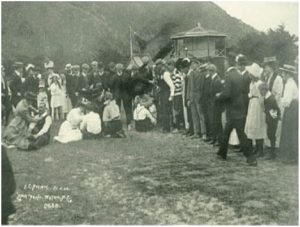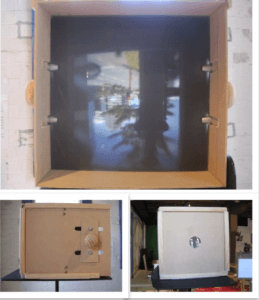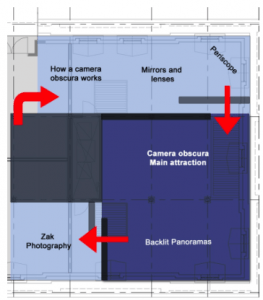Executive Summary
The Wellington Museums Trust has initiated a ten year redevelopment plan to incorporate the new ways of seeing arts, culture, heritage and Wellington concept into the missions of the organizations that it represents. As part of this initiative, the Museum of Wellington City & Sea is incorporating a new way of seeing by developing a camera obscura exhibition to provide a fresh perspective on the Wellington area. A camera obscura, Latin for “dark room”, was the precursor to the camera. The technology itself is simple, using only the reflection of outside images to project a real-time display in a dark space. The camera obscura will take advantage of the museum’s location in the city to give a new view of activity outside.
The camera obscura exhibition is intended to build upon the historical exhibitions and add interactive and educational experiences for all visitors. Our goal was to develop the supportive educational and interactive experiences as well as a marketing plan for a camera obscura exhibition at the Museum of Wellington City & Sea.
Methodology
Findings & Analysis
Recommendations & Conclusion
Methodology
To incorporate these factors and achieve our goal, we developed the following objectives:
- Design an educational programme and experience for the exhibition.
- Incorporate engaging and interactive features in the exhibition.
- Build and evaluate a camera obscura model.
- Develop a marketing plan for the exhibition.
Each of these objectives we used carefully designed methodological strategies to gather the information necessary to form a full recommendation. To complete our first objective, we gathered information on education in a museum setting by interviewing museum staff, reading teacher evaluations of educational programmes, and surveying visitors in the Telling Tales exhibition. To complete our second objective, we observed visitors and conducted interviews regarding interactivity, entertainment, and material-learned in the Telling Tales exhibition. We achieved the third objective by choosing, building, and evaluating a working small-scale camera obscura model to gauge visitors’ reactions to its interactive aspects and the unique view it offers. Finally, to meet the fourth objective, we interviewed museum staff on current marketing and revenue strategies, surveyed visitors on media usage, and interviewed local tourism experts about tour popularity.
Findings & Analysis
Educational experience
The educational programmes offered at the museum can be tailored to teacher requests and to meet the Learning Experience Outside The Classroom (LEOTC) requirements set by the Ministry of Education. Through reviewing education data and interviewing museum staff, we found that the best target audience for educational programmes is year-6 through year-8. We also discovered that more than half of the student groups visiting the museum were from the Wellington Region and Canterbury, on the South Island, is the second most represented region. The teacher comments revealed that the high levels of interaction and hands-on experiences currently employed in programs are highlights of the visit for both teachers and students. Additionally, we found that incorporating Science and Technology objectives from the New Zealand curriculum into the camera obscura exhibition would expand the museum past its social history focus.
Finally, to tie the exhibition back to the history of Wellington, we researched a Victorian Wellington photographer known as Zak. This historical connection will add to the educational experience for all visitors and ensure that the Victorian ethos of the museum is upheld. Below in Figure I is a Zak photograph of a camera obscura in Wellington in 1908.
Figure I: Zak photograph of a camera obscura from the Christchurch Exhibition in Wellington
Interactive experience
To find trends in visitor interaction and experience, each visitor interviewed was assigned a score based on their level of sensory engagement in the Telling Tales exhibition. We found that as a visitor’s sensory score increased, so did their reported retention of information and entertainment from the exhibition. The teacher comments also revealed that the sensory experiences offered in the museum were enjoyable for both the students and the teachers, indicating that both adults and children benefit from the museum’s current interactive displays.
Model evaluation
We evaluated visitor interaction with the camera obscura model through observations, which revealed that visitors needed initial context to establish visitor comfort. Most visitors were curious about the phenomenon and interacted with the model to figure out how it worked. Figure II below shows the model we built.
Figure II: Camera obscura model. Top: Translucent viewing screen showing an inverted image. Bottom Left: Side view of focus adjustment handles. Bottom Right: View of aperture and lens on front of model.
Marketing plan
Through museum staff interviews, we found that the museum pursues low-cost and resourceful marketing strategies to use the allocated budget efficiently. They capitalize on current events, create temporary exhibitions, and host well-known speakers or guests to promote the museum. The museum uses media, such as Event Finder, e-newsletters, and Facebook, to advertise these events in low-cost, long-term, and easily shared ways. Through our marketing survey, we found that most participants learned about the museum from signage, word of mouth, and brochures. However, participants answered that they mostly rely on television, Google, newspaper, and radio for advertising purposes. This reveals that these media could be utilized for the camera obscura exhibition as a more effective way to reach potential visitors.
Museum staff interviews revealed that proceeds from the retail shop and tours are the only sources of revenue for the museum. Some tours include transportation and multiple attractions for visitors, such as the Ship ‘n Chips tour which is their most popular tour. However, we observed that visitors were rushed to each attraction which left little time to spend in the retail shop. Interviews with local tourist experts revealed that tours that include more attractions are generally more popular. We found that informative brochures, appealing posters, and informed sales staff are all effective ways of advertising tours. Through retail records, it was apparent that New Zealand branded items were the most popular and that coffee table books and stationary items designed with more pictures than text were successful. It was apparent through our analysis that using New Zealand branded and exhibition-specific stationary could potentially be a popular item in the retail shop.
Recommendations and Conclusion
The recommendations for the interactive and educational experiences are presented in the order that a visitor would walk through the proposed camera obscura exhibition. Our recommended marketing plan includes marketing strategies and revenue generating suggestions.
Education and interactivity in the exhibition
As part of the museum’s redevelopment plan, the camera obscura exhibition will be located on the top floor of the museum which will be remodelled to have a layout similar to the other three exhibition floors. The exhibition is comprised of six segments which include an introductory diagram, mirror and lenses display, periscope, camera obscura main attraction, Wellington panoramic views, and historic Wellington photographs. We recommend that visitors move in a clockwise direction once they enter the top floor, as seen in the diagram in Figure III.
Figure III: Proposed camera obscura exhibition layout.
We suggest that the first segment provides a wall-mounted diagram and a description of the installed camera obscura to show how it works. This will explain the idea of the exhibition and the principles behind the camera obscura. As the visitor moves along, we recommend that the next segment of the exhibition features an interactive display involving mirrors and lenses. The purpose of this station is to teach visitors how the image in the camera obscura room is produced. The suggested mirror and lens display incorporates general interactivity and provides a hands-on learning method, which targets both hands-on learners and students that visit the museum. This segment can connect objectives from the Science and Technology learning areas of the New Zealand curriculum.
To encourage interaction within the exhibition, we suggest placing a periscope from the museum’s Collection Store in the corner of the exhibition space. Since the windows in this section of the top floor are partially blocked, we recommend that the periscope looks at an artificial 360 degree panoramic view from Wellington harbour. This suggested feature was designed primarily for interaction and to offer a new way of seeing Wellington.
The next two segments of the exhibition are contained within a darkened space seen in Figure III. The visitors first come in contact with the camera obscura display. The museum is currently evaluating the option of either a window-mounted or a roof-mounted camera obscura for installation. For both options, we recommend providing interactive objects that can be engaging for visitors of all age levels. For the next segment located in the same darkened space, we suggest hanging several panoramic images of Wellington’s city and harbour from the museum’s Collection Store and other sources. We recommend printing the images as transparencies so they can be backlit in the dark room and provide a new way of seeing both photographs and Wellington. We suggest incorporating pictures from the past to present to allow visitors to reflect on Wellington’s changes over time.
Finally, the exhibition will end with a segment about Joseph Zachariah, or Zak. This display will not only tell the story of Zak’s photography, but also feature the stories of the buildings and areas that define Wellington today. Photos in this section can be paired with pictures of current-day Wellington in the same settings as his photos from a century ago. By doing this, visitors will be able to once again reflect on the changes Wellington has undergone over past years. This segment, as well as the panoramas in the dark room, will connect to the objectives of the Social Science learning area in the New Zealand curriculum for the educational programme.
Once visitors conclude their time in the camera obscura exhibition, they can continue on to the interactive activities table. To connect the two sections of the entire floor, we suggest developing camera obscura related activities for the interactive table. Ideas for these activities might include hands-on camera obscura models and build-your-own pinhole cameras. Both of these activities are interactive and can encourage children to explore how the camera obscura phenomenon works. Similarly, children could replicate a sketch of the view of the camera obscura at the interactive table and then match their drawing with the view in the camera obscura room.
Marketing plan
To best market and promote the new exhibition, we recommend the museum advertise the opening of the exhibition on a large scale. We suggest reaching the target audience through what we found to be the most effective local and social media, including television, radio and Facebook. To provide lasting solutions for promoting the exhibition, we recommend developing annual events, such as Zak’s birthday celebration and designing exhibition-specific signage. To generate revenue, the next component of our marketing plan, we recommend developing stationary that is New Zealand branded and exhibition-specific, along with selling a coffee table book relating to the exhibition. Additionally, the museum can offer a paid tour including the camera obscura exhibition, a Wellington Cable Car ride, and the Carter Observatory.
Conclusion
In sum, developing a new exhibition takes considerable planning and preparation. The idea of bringing a camera obscura exhibition to the museum invited us to reflect on and develop educational and interactive experiences and a marketing plan that would complement the Trust’s new way of seeing concept. Since the exhibition is part of a larger redevelopment plan for the Museum of Wellington City & Sea, it was important to refer back to the new ways of seeing concept and to connect this vision to the social history theme of the museum. We believe our recommendations could engage visitors with thought provoking experiences, highlight the city and harbour through new attractions, and contribute to Wellington as the cultural capital.





